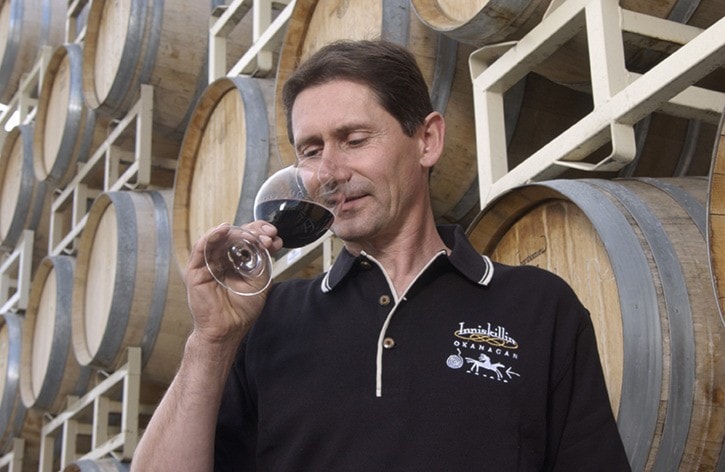The British Columbia wine industry, at least as we know it today, isn’t so old that we should forget its great builders. Even if we don’t exactly forget them, we certainly tend to take them for granted.
I’m talking about some of our longtime winemakers, primarily those with large wineries. This isn’t a finger-pointing exercise — I am certainly guilty in not paying much attention to them. After all, winemakers who are responsible for producing perhaps hundreds of thousands of cases of wine annually are probably too busy to be out and about in the public eye. We aren’t likely to see them when we belly up to a tasting bar.
That said, my attention was grabbed by an email I received this week celebrating Sandor Mayer’s 20th vintage as winemaker at Inniskillin’s B.C. winery.
The news set me to thinking about other senior winemakers, like John Simes, who joined Mission Hill Family Estate Winery in 1992 and was soon closely associated with the winery’s success — his fabulous Chardonnay wines were in no small part a kick-start to the Okanagan wine industry resurgence.
More than 30 years ago, a young Howard Soon was making off-dry white wines for Calona and he’s been with parent company Andrew Peller Ltd. ever since. Sixteen years ago, Soon’s profile was raised with the introduction of Sandhill, his small lots label that continues to be at the forefront. It is among the very best of B.C. wines.
When Stephen Cipes’s Summerhill Pyramid Winery was an emerging dream and he wanted to make sparkling wine, Cipes went to Europe. There he found a recent graduate from university wine studies in Germany. Eric von Krosigk became a partner and a friend and together they proved that the Kelowna area could produce some of the best bubblies in the planet.
These senior fellows of the B.C. winemaking biz, and this list is by no means exhaustive, are innovators and risk-takers. They never tire in their experimentation and pursuit of excellence.
In Mayer’s case, his experimentation with unproven varietals in the 1990s began with Zinfandel. It doesn’t seem like such a radical idea now, but that’s just because we have short memories.
“Back in the late 1990s people thought we were crazy to plant a big red like Zinfandel, when everyone else was planting Merlot,” he says. “They were skeptical we could get a late ripening varietal that does so well in California sufficiently ripe here. However, we’d done our research and I was fairly confident that with the right site selection and careful viticulture we would be successful. We knew the degree days, the southern site, sandy soil and vineyard aspects, all would make for ideal grape maturity. We just stayed quiet, believing that the wine would prove itself.”
Soon Mayer was overseeing the planting of Tempranillo. Later, he would continue to push the vinifera boundaries out with plantings of Pinotage, Sangiovese, Malbec, Marsanne and Roussanne. The impact of those plantings has been enormous.
A cofounder of Inniskillin commented on Mayer’s diverse skillset: “Sandor is amongst the very few winemakers who are also well skilled on viticulture. For this I admire and respect him. I enjoyed working with him as he always paid attention to the type of grapes he wanted to use and making sure of their best possible quality,” said Karl Kaiser.
No doubt others around him took note. Most successful winemakers now spend considerable time in vineyards, working to grow fruit that will ensure they are working with quality throughout the winemaking process.
The Hungarian-born Mayer is the son of a winery owner. He did his studies in Hungary and spent time working at a research station. He worked in Austria before coming to Canada. And for his entire career he’s been making first-rate wines in large quantities. As I think back, I can’t remember ever not enjoying a glass of Inniskillin wine.
There are winemakers whose names are better known, whose names and faces are instantly recognizable. But if winemaking had the equivalent of the tortoise and hare race, I’d be putting money on Mayer, the tortoise. Slow and steady wins the race.
Lorne Eckersley is the publisher of the Creston Valley Advance. His website, www.lorneeckersley.com, features a collection of columns, stories and photographs about wine, beer and spirits, food, travel and arts.
